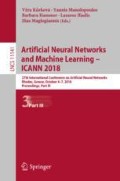Abstract
We improve the training time of deep feedforward neural networks using a modified version of gradient descent we call Predictor-Corrector Gradient Descent (PCGD). PCGD uses predictor-corrector inspired techniques to enhance gradient descent. This method uses a sparse history of network parameter values to make periodic predictions of future parameter values in an effort to skip unnecessary training iterations. This method can cut the number of training epochs needed for a network to reach a particular testing accuracy by nearly one half when compared to stochastic gradient descent (SGD). PCGD can also outperform, with some trade-offs, Nesterov’s Accelerated Gradient (NAG).
Access this chapter
Tax calculation will be finalised at checkout
Purchases are for personal use only
Notes
- 1.
One caution ought to be mentioned here: brain predictions also enable prejudices, so one must be careful how much trust is placed in predictions.
- 2.
Note that the jacobian, J, is not specific to the column of \(A_{t+1}\).
References
Andrychowicz, M., et al.: Learning to learn by gradient descent by gradient descent. In: NIPS (2016)
Beck, A., et al.: A fast iterative shrinkage-thresholding algorithm for linear inverse problems. SIAM J. Imaging Sci. 2(1), 183–202 (2009)
Cassioli, A., et al.: An incremental least squares algorithm for large scale linear classification. Eur. J. Oper. Res. 224(3), 560–565 (2013)
Daniel, C., et al.: Learning step size controllers for robust neural network training. In: AAAI (2016)
Dozat, T.: Incorporating Nesterov momentum into Adam. In: ICLR Workshop (2016)
Duchi, J., et al.: Adaptive subgradient methods for online learning and stochastic optimization. JMLR 12, 2121–2159 (2011)
Heeger, D.J.: Theory of cortical function. Proc. Natl. Acad. Sci. USA 114(8), 1773–1782 (2016)
Ho, Q., et al.: More effective distributed ML via a stale synchronous parallel parameter server. In: NIPS, pp. 1223–1231 (2013)
Hratchian, H., et al.: Steepest descent reaction path integration using a first-order predictor-corrector method. J. Chem. Phys. 133(22), 224101 (2010)
Kingma, D., et al.: Adam: a method for stochastic optimization. In: ICLR (2015)
Krizhevsky, A.: Learning multiple layers of features from tiny images. Technical report, Computer Science, University of Toronto (2009)
Krizhevsky, A.: cuda-convnet. Technical report, Computer Science, University of Toronto (2012)
Krizhevsky, A., et al.: ImageNet classification with deep convolutional neural networks. In: NIPS, pp. 1106–1114 (2012)
Luca, M.D., et al.: Optimal perceived timing: integrating sensory information with dynamically updated expectations. Sci. Rep. 6, 28563 (2016)
Neelakantan, A., et al.: Adding gradient noise improves learning for very deep networks. arXiv:1511.06807 (2015)
Nesky, A., et al.: Training neural networks using predictor-corrector gradient descent: Appendix (2018). http://www-personal.umich.edu/~anesky/PCGD_appendix.pdf
Nesterov, Y.: A method of solving a convex programming problem with convergence rate o(1/sqr(k)). Soviet Mathematics Doklady 27, 372–376 (1983)
Netzer, Y., et al.: Reading digits in natural images with unsupervised feature learning. In: NIPS Workshop on Deep Learning and Unsupervised Feature Learning (2011)
Polyak, B.: Some methods of speeding up the convergence of iteration methods. USSR Comput. Math. Math. Phys. 4(5), 1–17 (1964)
Scieur, D., et al.: Regularized nonlinear acceleration. In: NIPS (2016)
Simonetto, A., et al.: Prediction-correction methods for time-varying convex optimization. In: IEEE Asilomar Conference on Signals, Systems and Computers (2015)
Süli, E., et al.: An Introduction to Numerical Analysis, pp. 325–329 (2003)
Tieleman, T., et al.: Lecture 6a - rmsprop. COURSERA: Neural Networks for Machine Learning (2012)
Zeiler, M.D.: ADADELTA: an adaptive learning rate method. arXiv:1212.5701 (2012)
Zhang, Y., et al.: Prediction-adaptation-correction recurrent neural networks for low-resource language speech recognition. arXiv:1510.08985 (2015)
Zhang, Y., et al.: Speech recognition with prediction-adaptation-correction recurrent neural networks. In: IEEE ICASSP (2015)
Acknowledgments
This material is based upon work supported by the National Science Foundation Graduate Research Fellowship under Grant No. DGE-1256260. This work used the Extreme Science and Engineering Discovery Environment, which is supported by National Science Foundation grant number OCI-1053575. Specifically, it used the Bridges system, which is supported by NSF award number ACI-1445606, at the Pittsburgh Supercomputing Center.
Author information
Authors and Affiliations
Corresponding author
Editor information
Editors and Affiliations
Rights and permissions
Copyright information
© 2018 Springer Nature Switzerland AG
About this paper
Cite this paper
Nesky, A., Stout, Q.F. (2018). Training Neural Networks Using Predictor-Corrector Gradient Descent. In: Kůrková, V., Manolopoulos, Y., Hammer, B., Iliadis, L., Maglogiannis, I. (eds) Artificial Neural Networks and Machine Learning – ICANN 2018. ICANN 2018. Lecture Notes in Computer Science(), vol 11141. Springer, Cham. https://doi.org/10.1007/978-3-030-01424-7_7
Download citation
DOI: https://doi.org/10.1007/978-3-030-01424-7_7
Published:
Publisher Name: Springer, Cham
Print ISBN: 978-3-030-01423-0
Online ISBN: 978-3-030-01424-7
eBook Packages: Computer ScienceComputer Science (R0)

